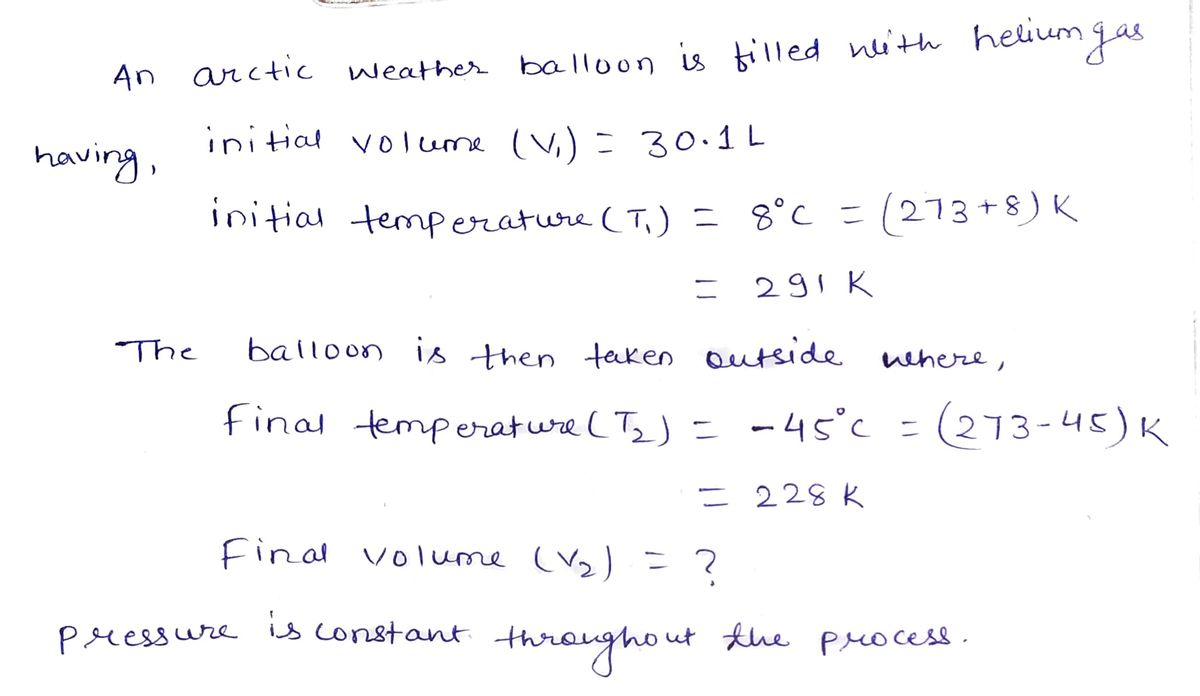An arctic weather balloon is filled with 30.1 L of helium gas inside a prep shed. The temperature inside the shed is 8. °C. The balloon is then taken outside, where the temperature is -45. °C. Calculate the new volume of the balloon. You may assume the pressure on the balloon stays constant at exactly 1 atm. Round your answer to 3 significant digits.
Ideal and Real Gases
Ideal gases obey conditions of the general gas laws under all states of pressure and temperature. Ideal gases are also named perfect gases. The attributes of ideal gases are as follows,
Gas Laws
Gas laws describe the ways in which volume, temperature, pressure, and other conditions correlate when matter is in a gaseous state. The very first observations about the physical properties of gases was made by Robert Boyle in 1662. Later discoveries were made by Charles, Gay-Lussac, Avogadro, and others. Eventually, these observations were combined to produce the ideal gas law.
Gaseous State
It is well known that matter exists in different forms in our surroundings. There are five known states of matter, such as solids, gases, liquids, plasma and Bose-Einstein condensate. The last two are known newly in the recent days. Thus, the detailed forms of matter studied are solids, gases and liquids. The best example of a substance that is present in different states is water. It is solid ice, gaseous vapor or steam and liquid water depending on the temperature and pressure conditions. This is due to the difference in the intermolecular forces and distances. The occurrence of three different phases is due to the difference in the two major forces, the force which tends to tightly hold molecules i.e., forces of attraction and the disruptive forces obtained from the thermal energy of molecules.
![**Problem:**
An arctic weather balloon is filled with 30.1 L of helium gas inside a prep shed. The temperature inside the shed is 8°C. The balloon is then taken outside, where the temperature is -45°C. Calculate the new volume of the balloon.
You may assume the pressure on the balloon stays constant at exactly 1 atm. Round your answer to 3 significant digits.
**Solution:**
This problem involves the application of the Combined Gas Law, particularly focusing on Charles's Law, since pressure remains constant. Here's the solution process:
1. **Identify the given variables:**
- Initial Volume (V₁) = 30.1 L
- Initial Temperature (T₁) = 8°C = 8 + 273.15 = 281.15 K
- Final Temperature (T₂) = -45°C = -45 + 273.15 = 228.15 K
- Final Volume (V₂) = ?
2. **Use the formula for Charles's Law:**
\[
\frac{V₁}{T₁} = \frac{V₂}{T₂}
\]
3. **Solve for V₂:**
\[
V₂ = \frac{V₁ \times T₂}{T₁} = \frac{30.1 \, \text{L} \times 228.15 \, \text{K}}{281.15 \, \text{K}}
\]
4. **Calculate:**
\[
V₂ ≈ 24.4 \, \text{L}
\]
Thus, the new volume of the balloon, after being taken outside, is approximately 24.4 liters when rounded to three significant digits.
**Note:**
Always convert temperatures to Kelvin in gas law calculations by adding 273.15 to the Celsius temperature.](/v2/_next/image?url=https%3A%2F%2Fcontent.bartleby.com%2Fqna-images%2Fquestion%2Faa7bca0c-1a52-4cc6-b8cd-1fb087a24077%2F2efc9f0f-a8ba-4db6-97e8-76e0008a40e6%2F88yoze8_processed.jpeg&w=3840&q=75)

Step by step
Solved in 3 steps with 2 images









